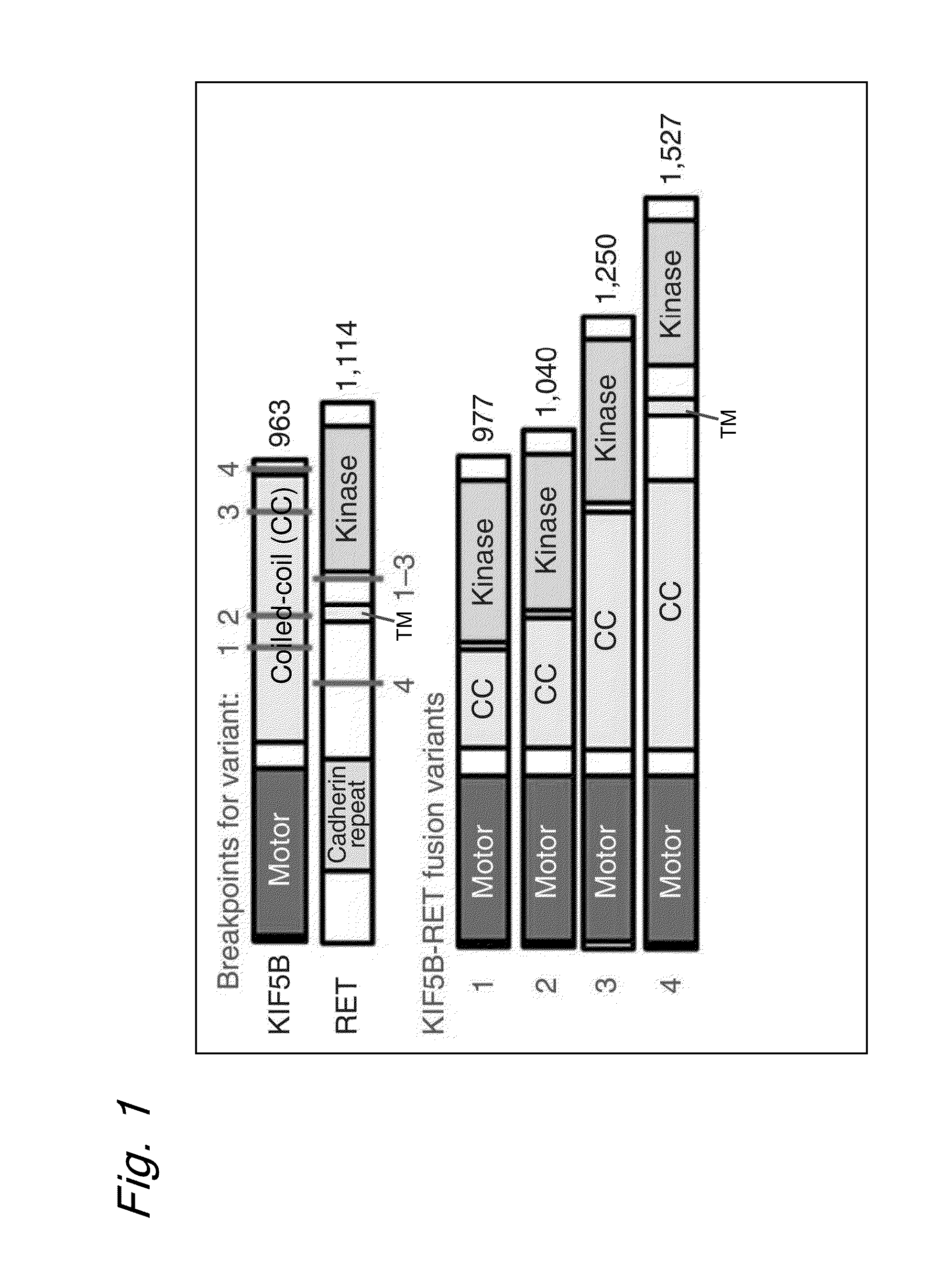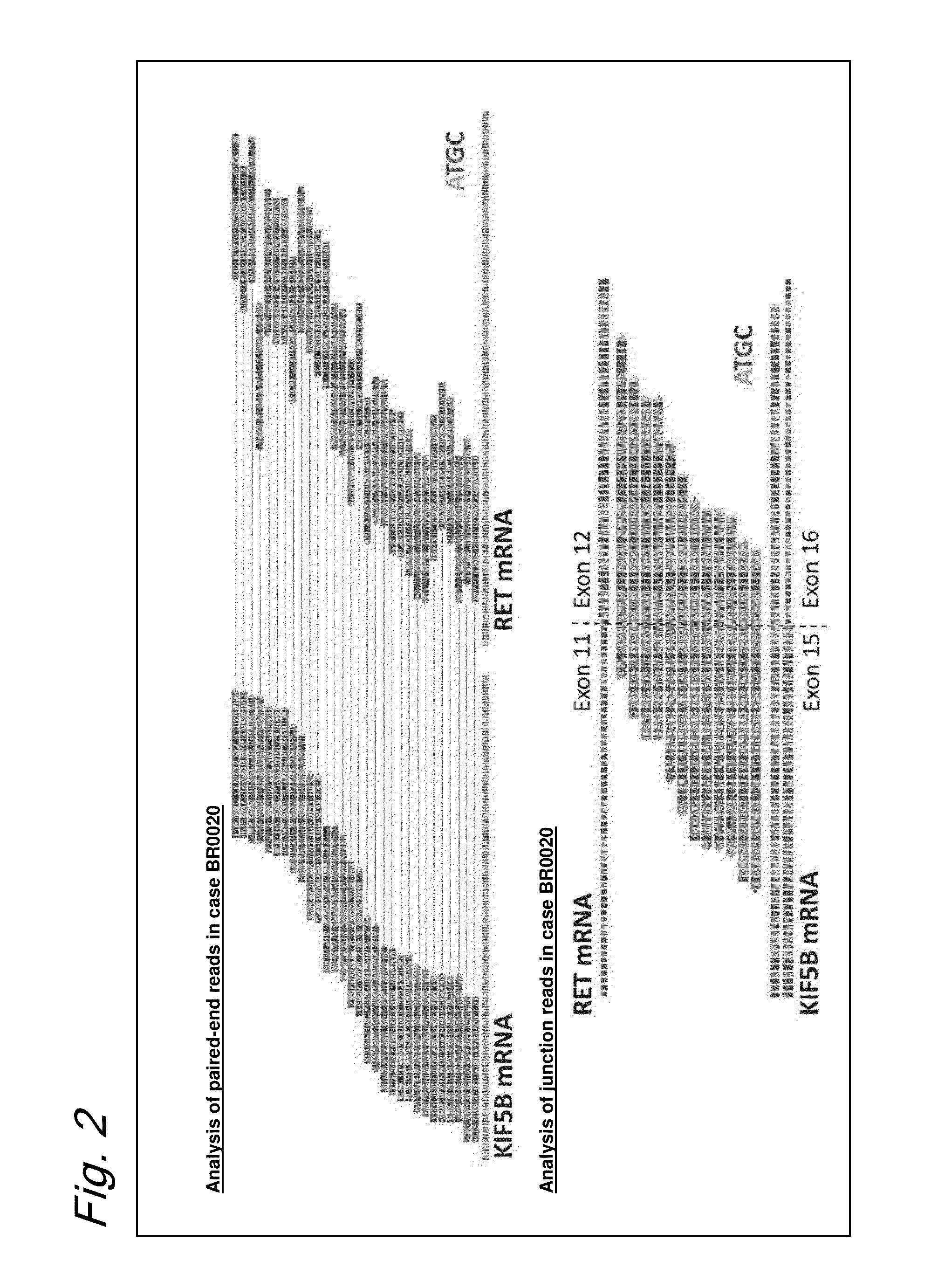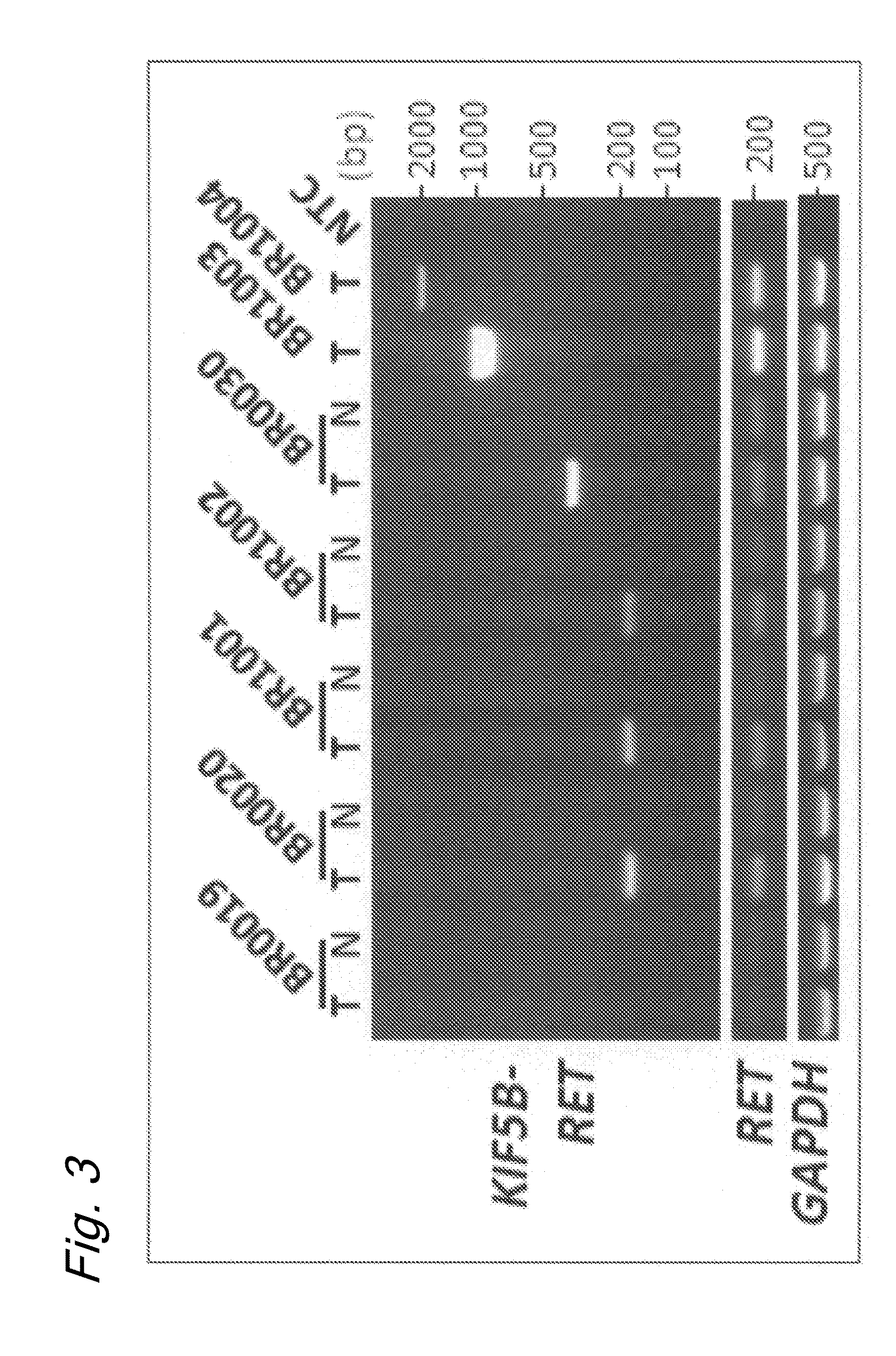Method for determining effectiveness of cancer treatment by assessing the presence of a KIF5B-RET chimeric gene
a chimeric gene and cancer treatment technology, applied in the field of fusion genes, can solve the problems of lung cancer, unreachable fusion gene elucidation, etc., and achieve the effect of efficient cancer treatmen
- Summary
- Abstract
- Description
- Claims
- Application Information
AI Technical Summary
Benefits of technology
Problems solved by technology
Method used
Image
Examples
example 1
[0152]First, in order to identify new chimeric fusion transcripts as potential targets for therapy, thirty LADC specimens and three associated non-cancerous tissues were subjected to whole-transcriptome sequencing (RNA sequencing; refer to Meyerson, M., et al., Nat Rev Genet, 2010, Vol. 11, p. 685-696). These 30 LADC specimens consisted of two with EML4-ALK fusions, two with EGFR mutations, two with KRAS mutations, and twenty-four without EGFR / KRAS / ALK mutations (refer to Table 2).
[0153]
TABLE 2Tumor orGeneSmokingPathologicalNo.Gene fusion (No. paired-No.SamplenormalSexmutationAge(Pack-years)stagetotal readend reads / junction reads)1BR0009TumorMaleALK30Ever-smoker (30)IIB30,067,759EML4-ALK (91 / 64)2BR0052*TumorFemaleALK38Ever-smoker (7)IIA27,841,176EML4-ALK (60 / 67)3BR0003TumorFemaleEGFR60Never-smokerIIB33,358,341TMEM209-DPP6 (61 / 16),ZNP862-WDR91 (24 / 22)4BR0044TumorMaleEGFR68Ever-smoker (10)IIB32,262,2345BR0005TumorMaleKRAS59Ever-smoker (62)IIB23,297,2676BR0016TumorFemaleKRAS75Never-smo...
example 2
[0157]Next, 319 LADC specimens from Japanese individuals, including 30 that had undergone whole-transcriptome sequencing, were subjected to RT-PCR screening and Sanger sequencing of the PCR products. The obtained results are shown in Table 3, FIGS. 3 and 4.
[0158]
TABLE 3JapanMutation typeVariableAll (%)EGFR a (%)KRAS a (%)ALK b (%)RET b (%)None (%)USATotal3191693011610380Age (mean ± SD; years)61.7 ± 8.661.0 ± 7.962.3 ± 9.153.5 ± 13.257.0 ± 15.263.6 ± 8.264.1 ± 9.7SexMale (%)158 (49.5)68 (40.2)19 (63.3)2 (18.2)3 (50.0)66 (64.1)42 (52.5)Female (%)161 (50.5)101 (59.8) 11 (36.7)9 (81.8)3 (50.0)37 (35.9)38 (47.5)Smoking habitNever-smoker (%)157 (49.2)92 (54.4)12 (40.0)7 (63.6) 6 (100.0)40 (38.8)5 (6.3)Ever-smoker (%)162 (50.8)77 (45.6)18 (60.0)4 (36.4)0 (0.0) 63 (61.2)73 (91.3)a Mutations detected by high-resolution melting assay.b Fusions detected by RT-PCR.
[0159]As shown in Table 3, FIGS. 3 and 4, the KIF5B-RET fusion transcripts were found to be expressed in 2.0% (6 / 319) of the specime...
example 3
[0161]Next, six RET fusion positive specimens were subjected to genomic PCR analysis. The obtained results are shown in FIGS. 5-10.
[0162]As shown in FIGS. 5-7, KIF5B intron 15, 16 or 24 at human chromosome 10p11.2 and RET intron 7 or 11 at chromosome 10q11.2 were found to be fused together at a somatic level.
[0163]The results also revealed that the evidence of no change in genome copy number at the two loci as shown in FIGS. 8 and 9 indicates that a chromosomal inversion had occurred between the long and short arms in the centromeric region of chromosome 10 as shown in FIG. 10.
[0164]The DNA sequences around the breakpoints in the genomes of the RET fusion positive specimens revealed no significant homology. Joining was effected without any nucleotide overlaps or insertions at the breakpoint of case BR0020, while insertions (BR1001 and BR1003) or overlaps (BR1002 and BR0030) were observed in other cases (refer to FIG. 6). Joining accompanied by the insertion of a 349 bp DNA fragment ...
PUM
| Property | Measurement | Unit |
|---|---|---|
| thick | aaaaa | aaaaa |
| frequency | aaaaa | aaaaa |
| chain length | aaaaa | aaaaa |
Abstract
Description
Claims
Application Information
 Login to View More
Login to View More - R&D
- Intellectual Property
- Life Sciences
- Materials
- Tech Scout
- Unparalleled Data Quality
- Higher Quality Content
- 60% Fewer Hallucinations
Browse by: Latest US Patents, China's latest patents, Technical Efficacy Thesaurus, Application Domain, Technology Topic, Popular Technical Reports.
© 2025 PatSnap. All rights reserved.Legal|Privacy policy|Modern Slavery Act Transparency Statement|Sitemap|About US| Contact US: help@patsnap.com



